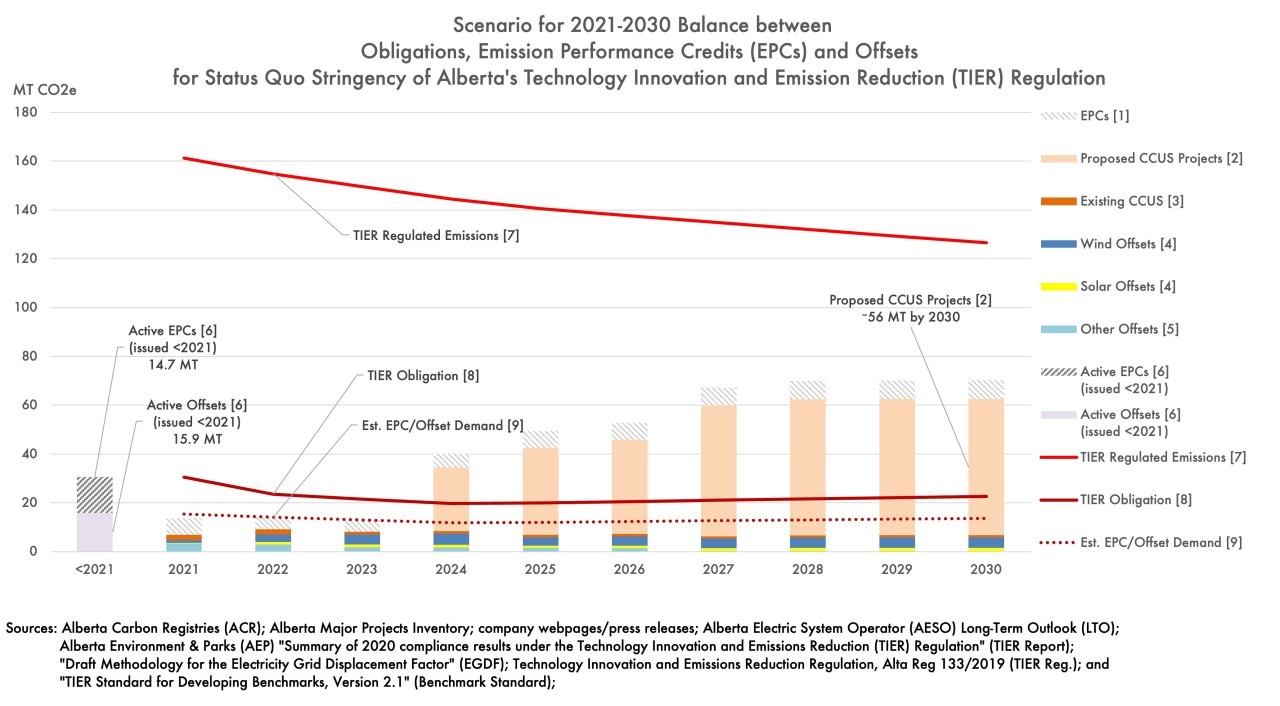The Canadian province of Alberta made major changes to its carbon credits system in preparation for a future surplus of carbon credits that may flood the market. Alberta expects many carbon capture and storage (CCS) projects to come online from 2024 until 2030.
The amendments are made under Alberta’s Technology Innovation and Emissions Reduction (TIER) Regulation (AR 133/2019). They include creating two new types of carbon credits – the “sequestration credit” and the “capture recognition tonne.”
The changes bring the TIER system in line with the minimum federal standards while ensuring that the carbon credits system continues to work in Alberta.
What is Alberta’s TIER?
TIER implements Alberta’s industrial carbon pricing and emissions trading system. It imposes an emissions benchmark on Alberta’s large emitters (emitting 100,000 tonnes or more of greenhouse gas) and opt-in facilities (smaller emitters that voluntarily opt in).
Facilities subject to TIER must meet their emissions benchmark by reducing their year-over-year operating efficiencies. In case they can’t meet the benchmark, they may choose to do any of these options:
- Buy a “fund credit” from the TIER for each tonne of excess emissions
- Submit Emission Performance Credits (EPCs) showing reduced emissions to below the benchmark in the previous or current compliance year
- Submit emission offsets generated under an approved protocol
EPCs are tradable to other emitters to meet their compliance obligations. TIER-regulated emitters are exempt from carbon pricing under the federal Greenhouse Gas Pollution Pricing Act.
CCS and Carbon Credits in Alberta
The carbon capture and storage industry, popularly known as CCS, is on the rise and Alberta is keeping up with the trend. The province agreed with 25 major CCS projects to explore potential project areas.
If all the projects go as planned, about 50-60 million tonnes of CO2 or its equivalent can be sequestered yearly. This can potentially create 50-60 million carbon credits. And that’s way more than expected of credits from projects under the TIER system.
Carbon offset credits issued to date are registered with the Alberta Carbon Registries (ACR). The body also publishes each offset project’s plan and verification of registered offsets. Each project’s plan estimates the annual emissions reductions the developer expects the project to yield.
Some think the flood of potential credits from CCS projects will cause their price to fall relative to the carbon price. This may restrict the deployment of CCS and the decarbonization of heavy emitters. These include Alberta’s power, oilsands, oil and gas, and other industries.
But estimates show otherwise as seen in the chart below (CCUS also means CCS).
Alberta TIER Carbon Credit Scenario (2021-2030)
Currently, a CCS project developer can create carbon credits for 20 years if it follows the Quantification Protocol for CO2 Capture and Permanent Storage in Deep Saline Aquifers.
A facility can retire the credits as part of its compliance obligations under the TIER. The credit holder can also sell them to another facility or a company looking for offsets.
Changes to Alberta’s Carbon Credit System
The major change to Alberta’s TIER regime is the creation of two new carbon credits.
- Sequestration credits:
Sequestration credits are also applicable under the Clean Fuel Standard. An offset can be converted into a sequestration credit if it meets certain criteria, which include:
- produced in 2022 or later year
- the CO2 sequestered must have been captured at a large emitter or opted-in facility (e.g. oilsands facility or fossil fuel power plant)
Sequestration credits may only be used for compliance for 5 years after generation.
Their creation may tell that some companies prefer to buy carbon credits from projects that permanently remove CO2 rather than projects that offset emissions. It will also be interesting to see if the new credit will trade at a premium price.
- Capture recognition tonnes:
Capture recognition tonnes allow emitters to deduct sequestered emissions from their total regulated emissions at carbon capture sites. A sequestration credit can be converted into a capture recognition tonne if:
- the CO2 sequestered for the emission offset was captured at the facility applying for the conversion, and
- the sequestration happened in 2023 or later.
The emitter can then retire the capture recognition tonnes and use them in calculating its net emissions from its facility. This will reduce its compliance emission obligations.
Other amendments:
The scope of “large emitters” now includes a facility that imports ~10,000 tonnes of hydrogen in 2023 or later.
They also lower the minimum emissions threshold for opt-in facilities in emissions-intensive trade-exposed industries from 10,000 CO2e tonnes/year to 2,000 CO2e tonnes/year. This enables smaller emitters to opt into the program and increase demand for offset credits.
Moreover, the current 8-year period for using EPCs will go down to only 5 years with a vintage year of 2023 or later. The amendments also expand the limit of using carbon credits in Alberta under TIER as a compliance method.
- For 2023, a facility can still meet its regulated emissions by up to 60% through retiring carbon credits. But this will go up to 70% in 2024, 80% in 2025, 90% in 2026, and any year thereafter.
The emissions intensity baseline will also be higher. A 2% annual tightening rate, from 1%, will apply to facility-specific and high-performance baselines. But for oilsands operations, this rate will go up to 4% in 2029 and 2030.
Lastly, the carbon tax under TIER for 2023 through 2030 will increase along with the federal carbon price from $65 to $170 in $15 annual increments.



